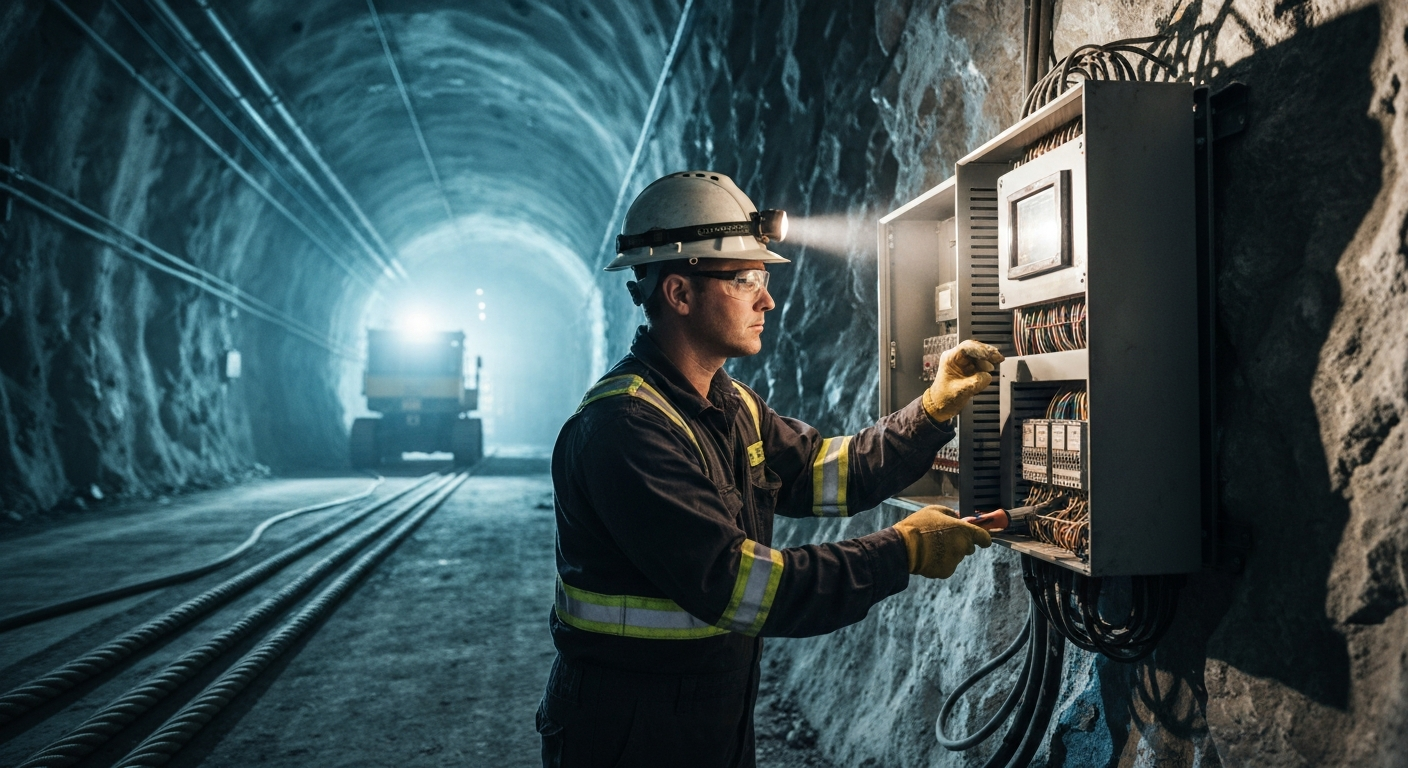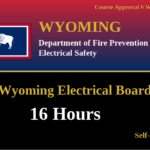
Electrical Safety in Wyoming’s Energy & Mining Industries
This article is a field guide for the licensed professional, offering perspective on the unique challenges and career-defining skills required to thrive in these demanding industries. We’ll explore the complex web of regulations, the critical importance of specialized safety procedures, and the foundational principles that keep these massive operations running safely.
The High-Stakes Environment: Navigating Wyoming’s Industrial Landscape
Wyoming’s economy is built on giants: energy and mining. From the vast coal reserves and the world’s largest Trona deposits to sprawling oil and gas fields, these industries present electrical challenges unlike any other. The focus on coal mine electrical safety is paramount, with specific protocols for everything from longwall miners to ventilation systems. For instance, ensuring proper Trona mine electrical safety involves dealing with potentially combustible dust and corrosive environments, demanding meticulous attention to enclosure types and wiring methods.
Similarly, the emphasis on oil and gas electrical safety involves navigating environments where flammable vapors are a constant threat. These areas often fall under Class I hazardous locations, where a single spark from improperly selected or maintained equipment can lead to a catastrophic explosion. In these settings, you’re not just wiring a building; you’re engineering a system to operate safely amidst some of the harshest conditions imaginable.
Core Safety Pillars: MSHA, OSHA, and NFPA 70E
For an industrial electrician, navigating the regulatory landscape is as crucial as reading a wiring diagram. While local and state rules provide a baseline, federal standards set the tone for heavy industry.
- MSHA Standards for Electricians: The Mine Safety and Health Administration (MSHA) is the governing body for all mining operations. Its regulations are law and cover everything from the construction of trailing cables to the grounding of massive surface equipment. MSHA’s rules are often more stringent than general industry standards due to the unique dangers of underground and surface mining.
- OSHA Regulations: The Occupational Safety and Health Administration covers a broader range of workplaces, including oil and gas extraction sites. OSHA’s standards, particularly those concerning the control of hazardous energy, are a cornerstone of industrial safety.
- NFPA 70E for Industrial Sites: While MSHA and OSHA state *what* must be done, NFPA 70E for industrial sites often explains *how* to do it safely. This standard, which addresses workplace electrical safety, provides the critical framework for creating an electrically safe work condition, conducting an arc flash hazard analysis, and selecting appropriate Personal Protective Equipment (PPE).
Adherence to these Wyoming electrical safety regulations isn’t just about compliance; it’s about a fundamental commitment to preventing injury and loss of life.
Arc Flash & High-Voltage Hazards: Beyond the Breaker Panel
In industrial settings, the scale of electrical energy is immense. An arc flash, an electrical explosion that can reach temperatures hotter than the sun’s surface, is a constant and deadly threat. A comprehensive arc flash hazard analysis is not an option—it’s an essential process mandated by NFPA 70E to determine the hazard level and required PPE. This involves complex calculations that go far beyond a simple visual inspection. Tasks that might seem routine in other sectors, like a circuit breaker replacement or performing high-voltage switching procedures, become high-risk events that require meticulous planning, specialized training, and a deep respect for the power involved.
Critical On-Site Safety Practices for the Industrial Electrician
Theory and regulations are vital, but safety is ultimately about what happens in the field. Three practices stand above the rest in Wyoming’s industrial environments.
1. Lockout/Tagout (LOTO): The Non-Negotiable Lifesaver
There is no more fundamental safety rule than de-energizing equipment before work. Effective lockout/tagout (LOTO) for mining and industrial plants is a lifeline. It ensures that machinery cannot be accidentally started while someone is performing service or maintenance. Nationally, LOTO violations are consistently among OSHA’s most cited standards, highlighting a dangerous gap between policy and practice. In a high-energy environment, a LOTO failure is almost always catastrophic.
2. Grounding, Bonding, and Hazardous Locations
In the vast, interconnected systems of a mine or refinery, proper grounding and bonding are what prevent disaster. Electrical grounding in mines is critical for protecting both personnel and equipment from fault currents. Just as important is bonding in hazardous locations, which ensures that all metallic components are at the same electrical potential, preventing sparks that could ignite flammable materials. Understanding the nuances of these systems is non-negotiable.
The National Electrical Code (NEC) provides detailed requirements for these applications. For electricians working in these fields, mastering topics like grounding and bonding in Class I locations is crucial. While much of Wyoming’s energy sector deals with Class I environments, a comprehensive knowledge of requirements for Class II locations (combustible dusts) is also vital, especially in coal and trona operations. Furthermore, the use of intrinsically safe equipment—devices designed to be incapable of producing a spark—is a key strategy in mitigating risk. Keeping up with code changes, such as new wiring requirements in hazardous locations, is part of a professional’s commitment to safety.
3. The Right Tools and Calculations
Professionalism in the industrial sector means precision. Distances in mines and oil fields can be vast, making accurate calculations essential. Using a voltage drop calculator isn’t just for efficiency; it ensures that equipment receives the correct voltage to operate safely and avoids creating overheating hazards in conductors. The right tool, whether a digital calculator or a calibrated torque wrench, is a safety device in its own right.
The Wyoming Industrial Electrician: Skills and Certification
Becoming an effective industrial electrician requires a significant investment in training and experience. The path often begins as an apprentice, leading to a journeyman electrician license after accumulating 8,000 hours of experience and 576 hours of classroom instruction. From there, many pursue specialized industrial electrician certification Wyoming or credentials from organizations like NCCER to validate their advanced skills. For those with entrepreneurial ambitions, the final step is often obtaining a Wyoming electrical contractor licensing, which requires years of experience as a journeyman. Continuous education is not just for license renewal; it’s a career necessity to keep pace with evolving technology and safety standards. If you’re looking to advance your knowledge, you can browse our courses designed for professional electricians.
Frequently Asked Questions (FAQs)
What is the most critical safety procedure for an industrial electrician in Wyoming?
Without a doubt, establishing an electrically safe work condition through a verified Lockout/Tagout (LOTO) procedure is the single most critical safety act. It is the first line of defense against shock and electrocution. This must be paired with a thorough arc flash hazard analysis before approaching any energized equipment.
Are MSHA standards for electricians different from OSHA?
Yes. While there is some overlap, MSHA standards are specifically written for the mining industry (coal, trona, etc.) and often contain more prescriptive requirements for electrical equipment and procedures in those unique environments. OSHA standards apply more broadly to general industry, including much of the oil and gas sector. An electrician working in a mine must comply with MSHA regulations first and foremost.
Wyoming Continuing Education Courses
Explore our board-approved continuing education courses for Wyoming professionals:
View CE RequirementsDisclaimer: The information provided in this educational content has been prepared with care to reflect current regulatory requirements for continuing education. However, licensing rules and regulations can vary by state and are subject to change. While we strive for accuracy, ExpertCE cannot guarantee that all details are complete or up to date at the time of reading. For the most current and authoritative information, always refer directly to your state’s official licensing board or regulatory agency.




